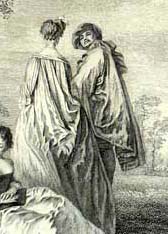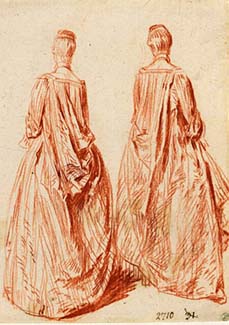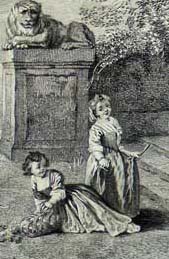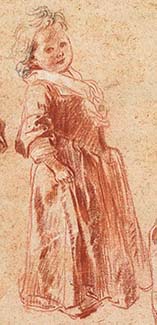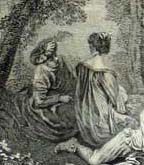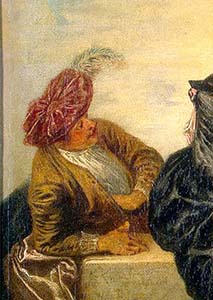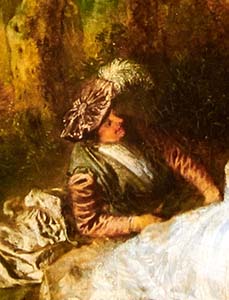
- Home Page
- Accepted
Paintings & Copies - Doubtful
Attributions - Doubtful Textual References
- Alternative
Titles - Collectors &
Museums - Bibliography
- Search Abecedario
- Watteau &
His Circle
Entretiens amoureux
Entered January 2022; revised February 2022

Presumed lost
Oil on panel
36.5 x 43.3 cm
RELATED PRINTS
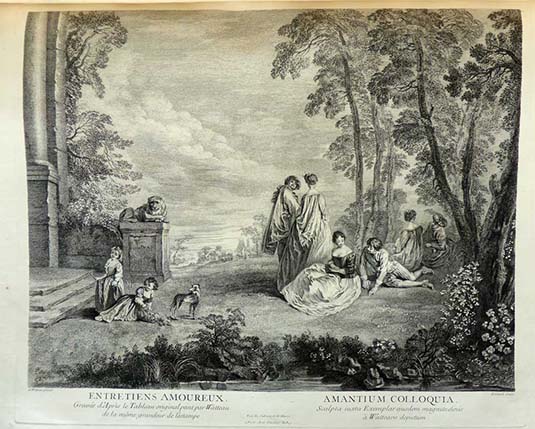
Jean Michel Liotard after Watteau, Entretiens amoureux, engraving, c. 1730.
Watteau’s painting, Entretiens amoureux, was engraved in reverse by Jean Michel Liotard. The print was not announced for sale in the Mercure de France.
PROVENANCE
Paris, collection of Jean-Baptiste Massé (1687-1767; engraver and miniature painter). Massé’s ownership of the painting is attested to on the engraving: “Tiré du Cabinet du Mr Massé.” The painting is not listed on the 1765-67 inventory of his art collection.
Paris, collection of Antoine Antonin, duc de Gramont. His sale, Paris, January 16ff, 1775, lot 60: “Antoine Watteau. . . Un Mezetin & une femme se promenent dans un jardin; deux autres figures de caractere & deux femmes assises. Au côté opposé deux enfants près d’une balustrade & d’un pilastre sur lequel est représenté un lion. Ce tableau peint sur toile porte 13 pouces 6 lignes de haut, sur 16 pouces de large.” Sold for 400.1 livres according to the annotated copy of the catalogue in the Frick Art Reference Library, New York. Bought by the dealer Alexandre Joseph Paillet.
Paris, collection of abbé Jean-Baptiste Guillaume de Gevigney (1729-1802; Généalogiste au service du comte de Provence, Garde des titres et généalogies de la Bibliothèque du Roi). His sale, Paris, December 1-29, 1779, lot 526: “Antoine Vatteau . . . Un Paysage agréable vu de l’Entrée d’un Jardin où est rassemblée une compagnie de six personnes; quatre sont assis & les deux autres se promenent en causant. Deux enfans jouent ensemble près des degrés d’un vestibule: ce Tableau admirable par sa touche spirituelle & son coloris brilliant, vient de la Collection M. le Duc de Grammont, & a été enlevé avec tout le succès possible de bois sur toile. H. 14 p. l. 17.” The painting sold for 420 livres according to an annotated copy of the sale catalogue in the Frick Art Reference Library, New York. Bought by the dealer Alexandre Joseph Paillet.
Paris, collection of Charles Alexandre de Calonne (1734-1802; statesman). His sale, April 21-30, 1788, lot 232: “Antoine Watteau . . . L’Intérieur d’un parc, où l’on voit huit figures d’hommes, de femmes & d’enfans qui se promènent. Haut. 13 pouc. large 17. T.” The painting sold for 133 livres according to annotated copies of the sale catalogue in the Frick Art Reference Library, New York, and in the Watson Library, Metropolitan Museum of Art, New York. The latter catalogue indicates that the picture was bought by the dealer Joseph Alexandre Lebrun.
SELECT BIBLIOGRAPHY
Hédouin, “Watteau” (1845), cat. 89.
Hédouin, Mosaïque (1856), cat. 90.
Goncourt, L’Art au XVIIIème siècle (1860), 57.
Goncourt, Catalogue raisonné (1875), cat. 131.
Dacier, Vuaflart, and Hérold, Jean de Jullienne et les graveurs (1921-29), 1: 262, 2: 34, 50-1, 96, 130, 3: cat. 124.
Réau, “Watteau” (1928), cat. 123.
Adhémar, Watteau (1950), cat. 125.
Mathey, Watteau, peintures réapparues (1959), 69.
Macchia and Montagni, L’opera completa di Watteau (1968), cat. 163.
Ferré, Watteau (1972), cat. B 90.
Roland Michel, Watteau (1981), cat. 203.
Roland Michel, Watteau (1984), 186.
Rosenberg and Prat, Watteau, Catalogue raisonné des dessins (1996), cat. 398, 508.
Rothlisberger and Loche, Liotard (2008), 2: cat. JMI.2.
RELATED DRAWINGS
Only two extant Watteau drawings can be associated with Entretiens amoureux.
One of the drawings that Watteau turned to is a sheet of studies in the Nationalmuseum, Stockholm (Rosenberg and Prat 398). There he selected the left hand study of a standing woman seen from behind, her gown billowing into soft folds at the waist.
The figure of the standing girl was derived from a sheet which has three studies of this charming child (Rosenberg and Prat 508).
While we cannot point to other extant drawings that Watteau used in the preparation of Entretiens amoureux, additional drawings were evidently available to him at the time. The half length figure of the man at the back of the picture, inclined and resting his weight on his bent arm, was apparently taken from a now-lost drawing that Watteau also used for figures in La Boudeuse and Plaisirs d’amour. A small study of this same man’s head, replete with feathered beret, is in Dresden (Rosenberg and Prat 332); that drawing, obviously a fragment, was undoubtedly cut from a larger sheet, one that probably contained fuller studies of the man that Watteau used for these three paintings.
REMARKS
In the eighteenth century when the painting came up for auction, there was no reference to Liotard’s engraving, or to the title that appeared on the engraving. Before the painting was sold in 1779 it was transferred from panel to canvas, suggesting that there were issues of condition.
The painting seems not to have survived beyond the eighteenth century. Although claims of authenticity have been made for a copy that emerged in the early twentieth century in the Jules Strauss collection, this work does not seem to be autograph (copy 1).
Scholars have not been particularly interested in Entretiens amoureux, but this has not stopped them from trying to assign it a date. Adhémar would place it in the years 1712-15, Roland Michel favored 1717, while Mathey claimed that it was painted in London in 1719. Rosenberg and Prat date the drawings of the woman to 1715-16, and the child to c. 1715-16. Remarkably, despite these slight divergences, there is an overall agreement.
For copies of Entretiens amoureux, CLICK HERE
